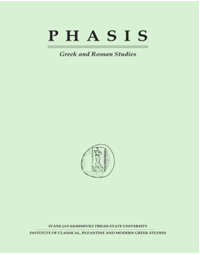From Dioskurias / Aia (Ochamchire) over Sebastopolis / Dioskurias (Skurcha) to Sukhumi / Sebastopolis. The Letter of the Episcopus Sanastupolitanus Inferioris Georgiae Reconsidered
DOI:
https://doi.org/10.60131/phasis.26.2023.7866Abstract
Traditionally, Dioskurias was equated with Sebastopolis and located at Sukhumi, although the literary and archaeological source base is rather slim and epigraphic and numismatic evidence is nearly absent. Recently, A. Coşkun (in VDI 80.2, 2020, 354-376; 80.3, 2020, 654-674) proposed to seek the location of Aia-Dioskurias near Ochamchire and its refoundation as Sebastopolis by Lake Skurcha. For this, he draws on the mythical and geographical traditions, which describe Aia and Dioskurias as situated in the “recess of the Black Sea.” River names and neighbouring tribes further suggest that the land- and riverscape of legendary Aia was developed from the environs of Dioskurias / Ochamchire. Ancient itineraries and periplus literature further seem to support this reconstruction. T. Schmitt (2022, 14-44) has tried to refute the new approach. After closely comparing the arguments and counter-arguments, Coşkun’s position can be further strengthened. Schmitt, however, adduces for the first time important Medieval evidence, including a letter of the episcopus Sanastupolitanus inferioris Georgiae (1330). But this is not sufficient to prove that Sebastopolis lies buried under Sukhumi. After exploring the context of Genoese colonial activities and king George V’s fight for independence from Ilkhanid and Mongol occupation, it will be suggested instead that the Catholic bishop of Sukhumi became the titular successor of the then defunct Orthodox bishopric of nearby Sebastopolis-Skurcha.
Downloads
Published
Issue
Section
License
Copyright (c) 2023 PHASIS

This work is licensed under a Creative Commons Attribution-NonCommercial 4.0 International License.


